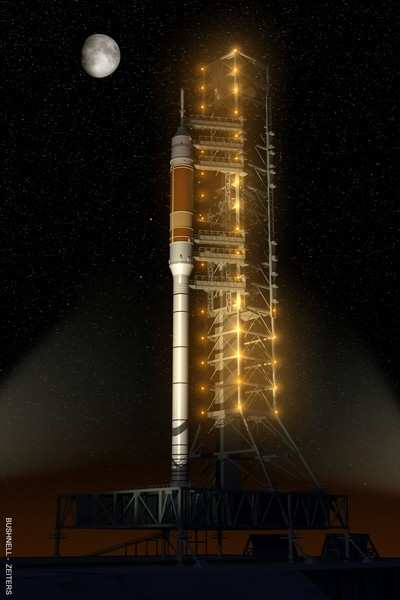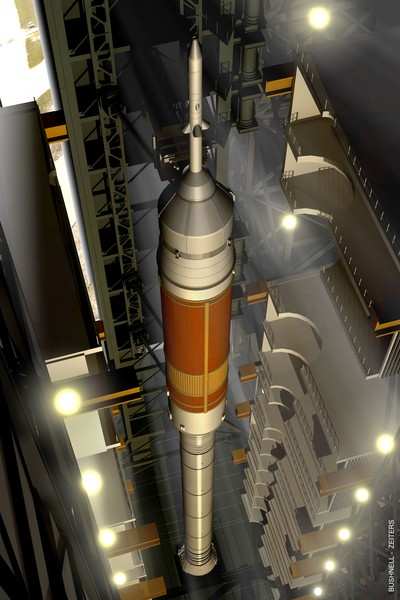First Such Milestone For A US Rocket In Over 35 Years
NASA announced Wednesday a major step toward building the
nation's next generation launch vehicle, with the successful
completion of the Ares I rocket preliminary design review.

Starting in 2015, the Ares I rocket will launch the Orion crew
exploration vehicle, its crew of four to six astronauts, and small
cargo payloads to the International Space Station. The rocket also
will be used for missions to explore the moon and beyond in the
coming decades.
The preliminary design review is the first such milestone in
more than 35 years for a US rocket that will carry astronauts into
space. The review was conducted at NASA's Marshall Space Flight
Center in Huntsville, Ala. It examined the current design for the
Ares I launch vehicle to assess that the planned technical approach
will meet NASA's requirements for the fully integrated vehicle.
That ensures all components of the vehicle and supporting systems
are designed to work together.
"This is a critical step for development of the Ares I rocket,"
said Rick Gilbrech, associate administrator of the Exploration
Systems Mission Directorate in Washington. "Completing the
preliminary design review of the integrated vehicle demonstrates
our engineering design and development are on sound footing, and
the Ares I design work is taking us another step closer to building
America's next mode of space transportation."
The preliminary design review included more than 1,100 reviewers
from seven NASA field centers and multiple industry partners. The
review is the final step of this design process. Teams representing
each major part of the Ares I rocket -- the upper stage engine,
first stage and upper stage -- all have conducted similar reviews
during the past year.
 The preliminary design review is one of a series of reviews
that occurs before actual flight hardware can be built. As the
review process progresses, more detailed parts of the vehicle
design are assessed to ensure the overall system can meet all NASA
requirements for safe and reliable flight. This process also
identifies technical and management challenges and addresses ways
to reduce potential risks as the project goes forward.
The preliminary design review is one of a series of reviews
that occurs before actual flight hardware can be built. As the
review process progresses, more detailed parts of the vehicle
design are assessed to ensure the overall system can meet all NASA
requirements for safe and reliable flight. This process also
identifies technical and management challenges and addresses ways
to reduce potential risks as the project goes forward.
"Risk assessment is a very important part of the process," said
Steve Cook, manager of the Ares I rocket at Marshall. "It allows us
to identify issues that might impact the Ares I rocket. For
example, we identified thrust oscillation -- vibration in the first
stage -- as a risk. In response to this issue, we formed an
engineering team. The team conducted detailed analyses and reviewed
previous test data, and then recommended options to correct the
problem."
"We intend to hold a limited follow-up review next summer to
fully incorporate the thrust oscillation recommendations into the
stacked vehicle design," Cook added. "Identifying risks that can
impact the project and resolving them is a necessary and vital part
of the development process."
Last month, NASA announced a fix for one of those risks -- a
thrust oscillation issue, stemming from the rocket's configuration.
As ANN reported, NASA confirmed it will attach
16 remote-controlled vibration dampeners, each with 100-lb weights
attached to springs able to be moved up and down as needed to
counteract such vibrations.
A 17th so-called "shock absorber" will be mounted near the
rocket's midsection, using a ring of such weights and springs to
stop vibrations from reaching the Orion manned capsule atop the
rocket.
With the completion of this review, each element of the Ares I
rocket will move to the detailed design phase. A critical design
review will mark the completion of the detailed design phase and
allows for a more thorough review of each system element to ensure
the vehicle design can achieve requirements of the Ares
program.
This week, the J-2X engine will be the first Ares I element to
kick off the critical design review process. The engine will power
the Ares I upper stage to orbit after separation from the first
stage.

"We're excited about getting into full system engine tests with
the new J-2X engine," Cook said. "This will be one of the safest,
most affordable and highest performing rocket engines ever built,
and testing is critical as we begin preparation for future
flights."
Marshall manages the Ares projects and is responsible for design
and development of the Ares I rocket and Ares V heavy cargo launch
vehicle. NASA's Johnson Space Center in Houston manages the
Constellation Program, which includes the Ares I rocket, the Ares V
vehicle, the Orion crew capsule and the Altair lunar lander. NASA's
Kennedy Space Center in Florida is responsible for ground and
launch operations. The program also includes multiple project
element teams at NASA centers and contract organizations around the
US.
 ANN's Daily Aero-Linx (04.15.24)
ANN's Daily Aero-Linx (04.15.24) Classic Aero-TV: 'No Other Options' -- The Israeli Air Force's Danny Shapira
Classic Aero-TV: 'No Other Options' -- The Israeli Air Force's Danny Shapira Aero-News: Quote of the Day (04.15.24)
Aero-News: Quote of the Day (04.15.24) Airborne 04.16.24: RV Update, Affordable Flying Expo, Diamond Lil
Airborne 04.16.24: RV Update, Affordable Flying Expo, Diamond Lil ANN's Daily Aero-Term (04.16.24): Chart Supplement US
ANN's Daily Aero-Term (04.16.24): Chart Supplement US





